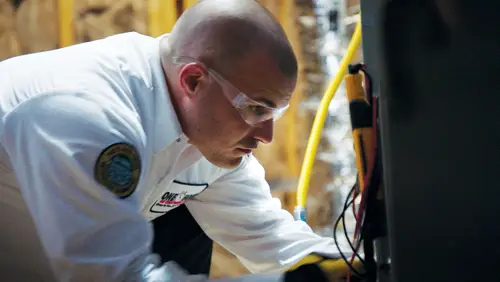What’s a Furnace Pilot Light?
A furnace pilot light is a tiny flame that ignites the burners of gas or oil-burning furnaces. This flame acts as the spark source, making it possible for the furnace to generate heat when needed.
You’ll find pilot lights in furnaces, water heaters, and even fireplaces. It’s this small flame that gets the big burners going when your home needs some warmth. Without a functioning pilot light, the heating appliance can’t do its job of warming your home.
How a Furnace Pilot Light Works
Pilot lights generally fall into two categories: constantly burning (standing pilot) and intermittent ignition. Constantly burning pilot lights maintain a small flame at all times, ready to ignite the furnace burners whenever heat is required. This type is typically found in older furnace models.
On the other hand, intermittent ignition systems light the pilot only when needed. The on-demand type is more common in newer, energy-efficient models, which can lead to greater energy savings since the flame isn’t burning constantly.
The ignition method can vary as well. Traditional systems may require manual ignition using a match or lighter, while newer models often feature electronic igniters for better reliability and safety.
Safety features are a must-have for pilot light operation. Furnaces are equipped with components like thermocouples or flame sensors that detect the presence of a flame. If the pilot light goes out, these devices automatically turn off the gas supply to avoid leaks and reduce the risk of carbon monoxide exposure. You can also adjust the size of the pilot light’s flame to promote optimal combustion and overall efficiency.
Checking If the Furnace Pilot Light Is Out
To see if the pilot light is out, pop open the access panel on your furnace. Look for a small blue flame within the pilot light assembly. If you don’t see a flame, the pilot light is out. A healthy pilot light should burn steadily with a blue flame, indicating complete combustion. A flickering or yellow flame may point to a malfunction or incomplete combustion, which could create a safety issue.
If your pilot light’s out, don’t panic! Relighting it isn’t rocket science, but you do need to be careful.
Follow these steps to relight a pilot light: First, turn off the furnace using the gas control knob. Wait a few minutes to allow any residual gas to clear. Next, turn the knob to the ‘pilot’ position. Hold down the reset button while using a match to light the pilot. Once you see the pilot light burning steadily, let go of the reset button and turn the knob back to the ‘on’ position.
At this point, you’re good to go! But always use caution when handling gas appliances.
Handling an Electric Heater Pilot Light
Electric heaters usually have a simpler pilot light operation. To relight an electric pilot light, find the switch or knob near the heater and set it to the ‘pilot’ position. Press and hold the lighting button until the pilot light ignites.
If the pilot light doesn’t ignite after several tries, it’s a good idea to stop and call the pros. Continuing with unsuccessful attempts can lead to gas buildup, creating a serious safety hazard.
Dangers of a Pilot Light Going Out
A pilot light going out can be more than just an inconvenience. It can actually be dangerous. If the pilot light is out, gas can accumulate, increasing the likelihood of an explosion. Modern furnaces typically come with failsafe electrical shut-off valves designed to stop the gas flow automatically if the pilot light goes out, adding a layer of protection.
A common sign of a gas leak is the odor of sulfur or rotten eggs. If you notice this smell, leave the area immediately, avoid using electrical devices, and contact your gas company or emergency services. Quick action can prevent dangerous situations.
Best Practices for Furnace Pilot Lights
To keep your pilot light happy and maximize safety, consider turning off the pilot light during the summer when heating isn’t required. This simple step can help save energy, reduce gas usage, and prolong the pilot assembly’s life.
We also recommend routine maintenance, such as cleaning the pilot light tip. Over time, debris and dust can buildup, potentially blocking the flame and affecting ignition.
To clean the pilot light tip, first, turn off the furnace. Use a degreasing solution to clean the tip, then gently brush it with a small brush to remove any residue. Rinse the area, reassemble the components, and make sure everything is securely in place before attempting to relight the pilot light. Regular cleaning helps keep the system operating smoothly and lowers the risk of malfunction.
Service Minds One Hour Professional Assistance for Furnace Pilot Light Issues
For pilot light problems, getting professional help is often the best option. At Service Minds One Hour Air Conditioning & Heating in Tampa, FL, we specialize in expert furnace repair services. Our certified technicians are superheroes of the heating world and can handle various furnace issues, swooping in to save you from the cold!
If you live in the Tampa area and are having trouble with your furnace pilot light or experiencing other heating problems, don’t hesitate to contact us at Service Minds One Hour Air Conditioning & Heating. We focus on quality service and the safety and comfort of your home. Don’t let furnace troubles leave you shivering. Reach out to the experts and get that cozy warmth back in your home!
Helpful Resource:
